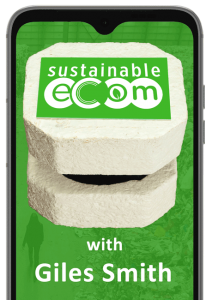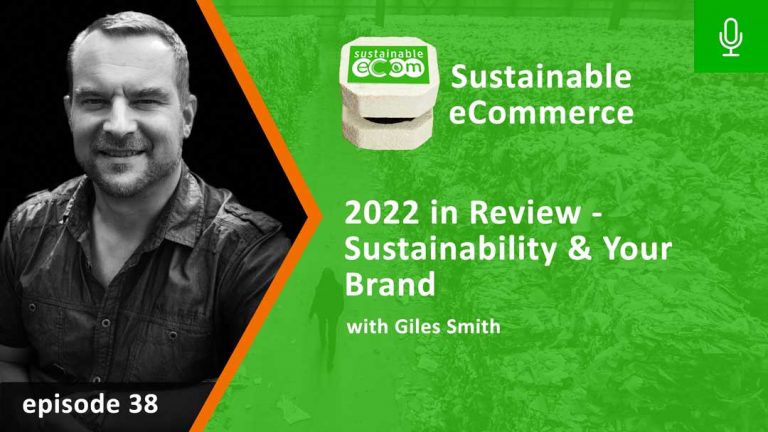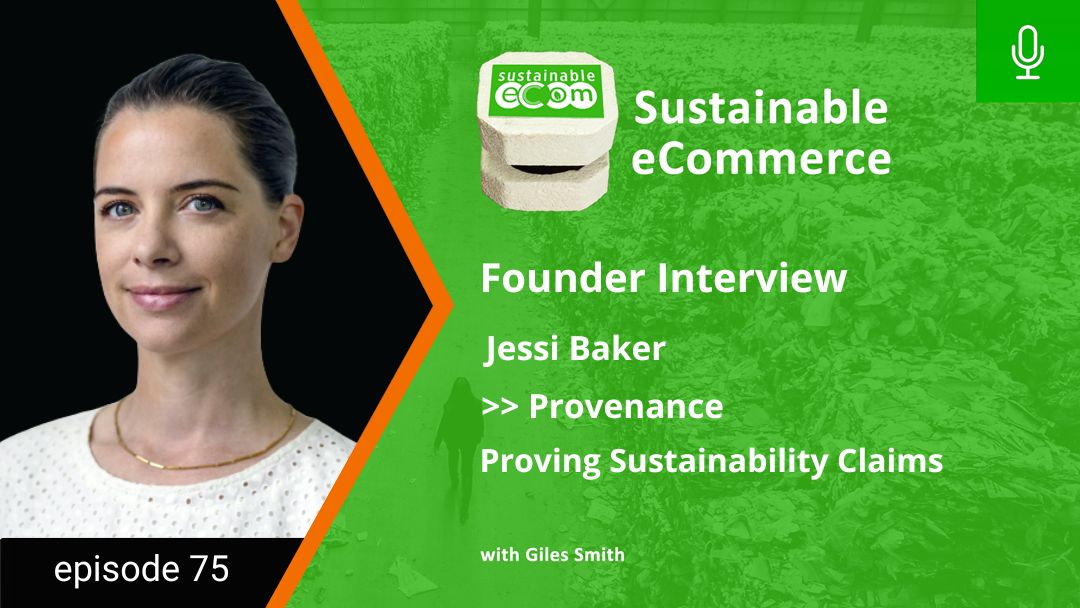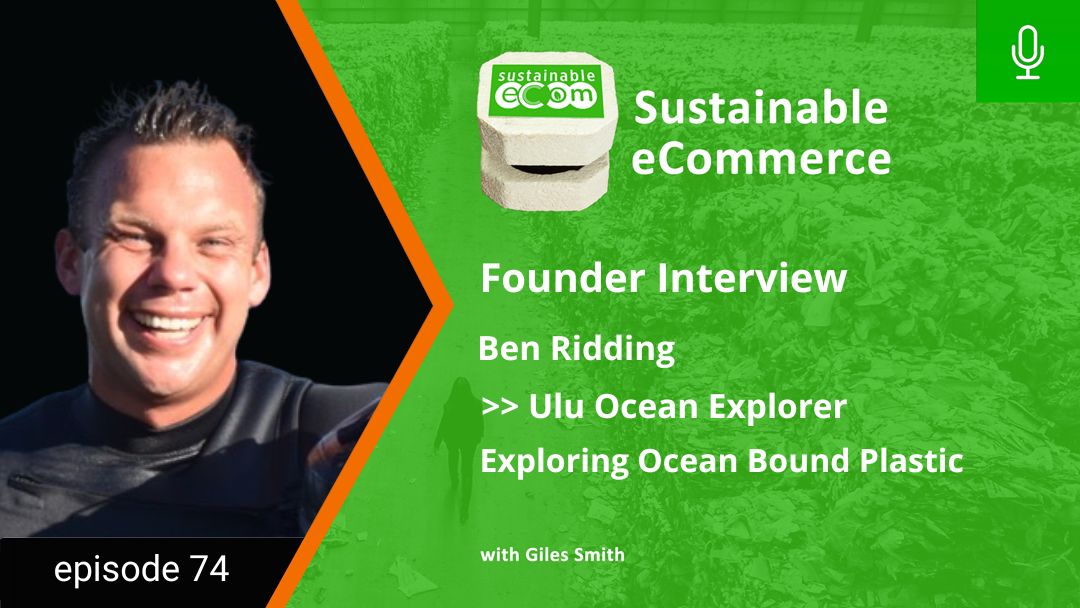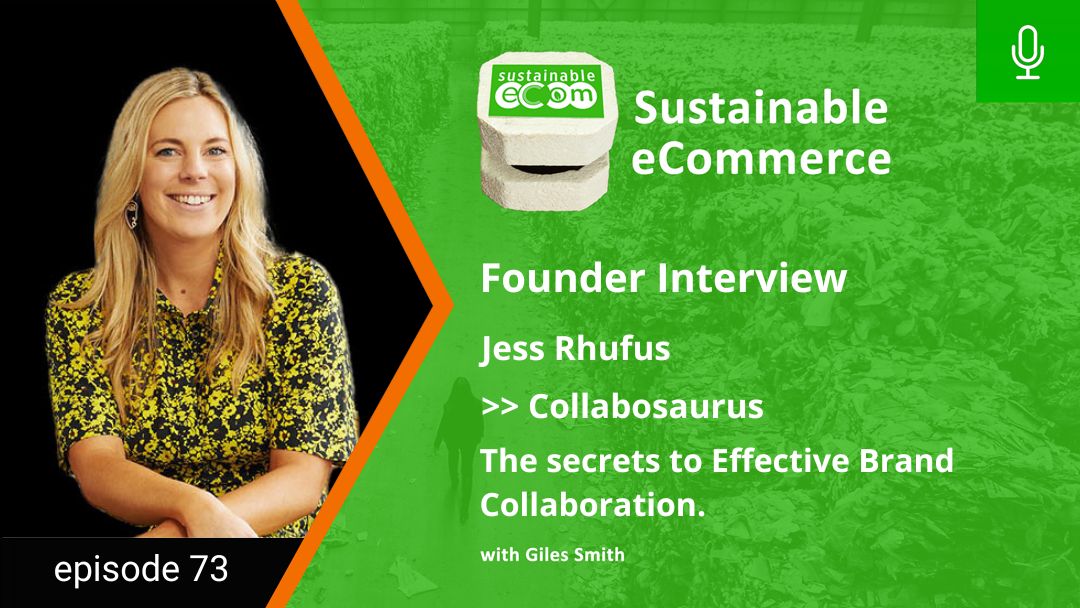Sustainable Ecommerce Podcast - Episode 38
As you head into the holiday period lull, it’s important to give your brain and your body some downtime. Reconnect with family & friends, reconnect with nature, and reflect on the year that was.
So in this episode, the final show for 2022, I thought it would be a good time to look back over some of the interesting and memorable things that happened over the past 12 months in the sustainability space, as well as encourage you to look back and celebrate your own year of accomplishments.
What Is Consumer Sentiment Towards Sustainability in 2022?
2022 for many of us has felt like another unexpectedly different year in what seems to be a trend of ongoing ‘new normals’. Moving into a post-pandemic world hasn’t necessarily been the smooth transition we were expecting with rising geopolitical challenges, the economy paying the piper for all that pandemic stimulus, and ongoing supply chain dramas that make you want to pull your hair out.
So my first topic to reflect on for this year is, how have the changing conditions affected consumer sentiment towards sustainability? We know it emerged as a key focus during the pandemic, but has that fallen away as people transitioned back to getting on with their daily lives, especially now that they’re challenged with the double squeeze on spending from inflation and interest rates.
The good news is that several reports came out during the year indicating that both consumer sentiment and consumer intention towards sustainability was as strong as ever, indeed continues to grow.
The IBM Centre for Business Value released a report back in Q1 indicating that in 2022 80% of consumers say that sustainability is important, 50% say they are willing to pay a premium for sustainable products, and 62% say they’re willing to change their purchasing habits to reduce environmental impact, which was actually up from 57% in 2020.
Another survey conducted here in Australia by Nine & iCrowd.DNA showed a shift in consumer expectation away from reliance on the government to act on climate change, and towards brands delivering a more sustainable future. 74% said they wanted brands to lead the way and make bold moves to help them live more sustainably, yet fully 40% said they were unable to name any brands that were effective in doing it. Please do take note of that disparity if you’ve felt the need to hold back sustainability messaging for your brand. Consumers want you to be taking action and helping them do better, and the only way they’re going to know about it is if you communicate it! The report also highlighted that consumers want to see progress, not perfection, which goes back to the running theme through this podcast, which is that sustainability is a journey!
And one more research report from the second half of this year, by LEK Consulting across consumers in the UK, US and Australia found that rather than diminishing in light of economic turbulence, consumers expectations on brands for sustainable solutions continues to rise, with 60% of people saying they were looking for products that avoided certain materials, with plastic reduction being the main focus. More than 50% of consumers surveyed said they would still be willing to pay more for sustainable products. Once thing that was interesting for me was the more US consumers said they were willing to pay more than in the UK and Australia, but Australians are most willing to pay more for sustainable pet products and beauty products.
My take on all that is that I think we’ve hit a tipping point with consumer attitudes to sustainability in 2022. Despite all the economic turbulence and uncertainty, consumer demand for sustainable products, their expectations on brands to help them buy better, their willingness to make changes in their habits to support the environment and even their willingness to pay a bit more to achieve all that is greater than ever.
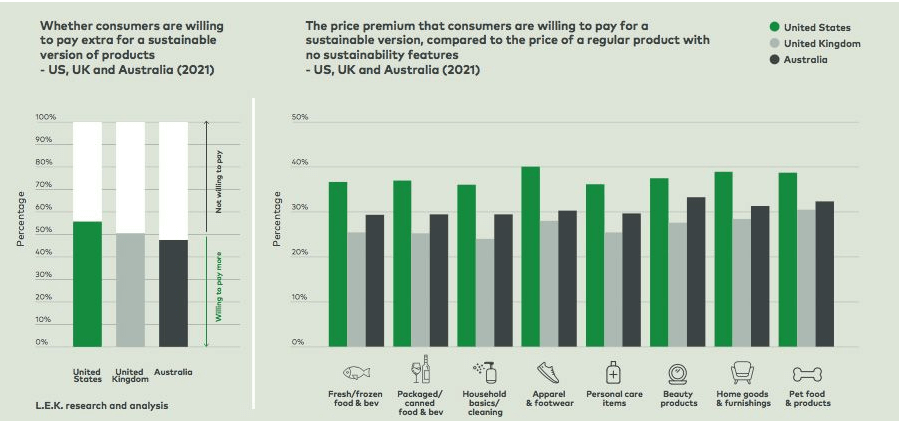
Greenwashing Continued to Be an Issue - And an Increased Focus for Regulators in 2022
Talking of consumer sentiment. Nielsen published a report this year showing that only 50% of consumers trust the environmental claims made by brands.
That’s hardly surprising given the number of big brands that seem to get picked up for greenwashing. A case in point from this year is SUKIN, a much- loved Aussie icon in sustainable personal care space. They are currently in a high profile legal battle over their claims about being Carbon Neutral. Allegedly, they have been using the carbon neutral logo in their labelling and marketing without getting certified or doing the work to reduce their footprint. As we heard from Richie Mulder a couple of weeks ago, that kind of behaviour is almost guaranteed to get you in hot water, not to mention stoke the fires of greenwashing suspicion among consumers, so it’s been good to see regulators like the ACCC start cracking down on it this year.
In May the ACCC officially announced that Greenwashing was going to be one of its major focus areas for the year, and they followed that up with announcements of a big internet sweep in August. Their focus has been largely on Carbon related claims more than anything else, which is not surprising given that’s been governments sole sustainability focus for decades. It’s good to see them taking action, assuming any action actually comes from it. They report targeting around 200 websites in their sweep, which doesn’t seem like many in the grand scheme of things.
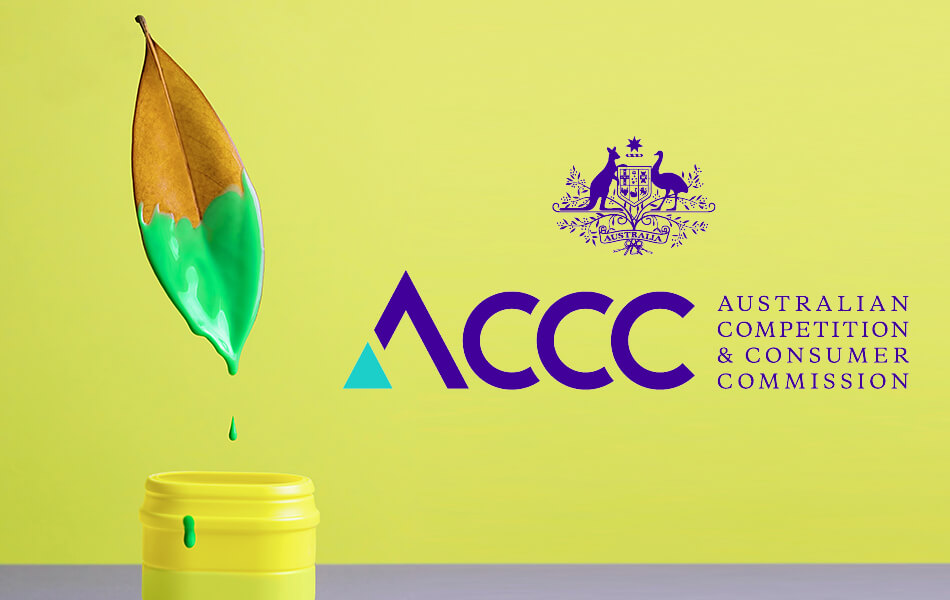
Obviously, it’s not just here in Australia where we’ve seen action being taken on greenwashing, some big moves Europe this year too. It might be an eye opener that this is even possible, but under existing classifications, fossil gas production can be classified as green energy in the EU currently, meaning that fossil fuel projects could get funding through green investment schemes. So it was good to see MEPs call that out as greenwashing and vote to change that back in June.
And, more broadly, The Council of the EU has been investigating the mixed bag of sustainability claims in big business, finally giving the green light to implement the corporate sustainability reporting directive, which will harmonise sustainability reporting standards and increase accountability for big business to track, and report on how their business operations are impacting the environment.
Fashion Industry Still Rife with Greenwashing
The Fashion Industry continues to be front and centre in relation to greenwashing through this year.
The big notable news related to the fall from grace of the HIGG index, one of the leading toolsets for sustainability measurement in the apparel industry.
On the face of it, the index seems to provide a very comprehensive analysis, from materials, through supply chain impact, industry standards and ethics. It would seem to be a tool with vast potential to address most ecological and social concerns currently plaguing fashion industry. However, when something seems too good to be true, it often is.
It transpires that not only does the index favour synthetic fabrics over natural fibres on the sustainability score, but it also goes a step ahead and rates polyester as one of the most sustainable fibres in the world, leaving behind cotton, silk and wool, bamboo, hemp and just about every other natural fiber.
Perhaps that isn’t surprising given that the big name brands leading the Sustainable Apparel Coalition, who designed the index have a heavy reliance on Polyester.
But earlier this year the research underlying the index was called into question, leading the Norwegian Consumer Authority, the equivalent of the ACCC here in Australia to implement a blanket ban on use of the HIGG index for marketing and in garment labelling.
What portent that has for other parts of Europe and the EU remains to be seen, but it certainly opens the door for independent sustainability assessments.
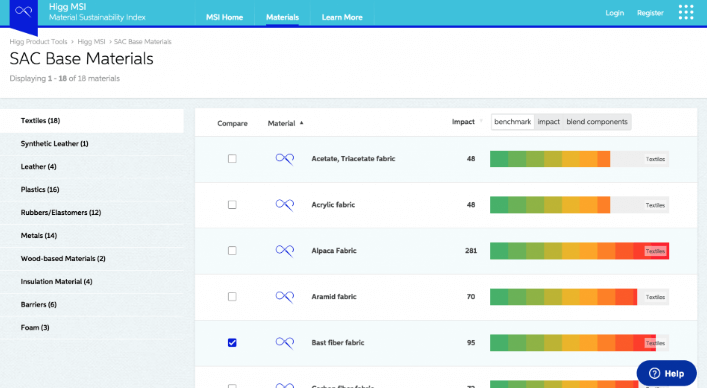
My take on all that is that providing 3rd party certification to prove the sustainability of your products and improvements you’ve made to operations is important, but it isn’t going to be sufficient to win the hearts and minds of your customer base. I’m sure that cases like the Higg Index and Sukin will continue to crop up, and continue to undermine consumer confidence in the trustworthiness of badges on their own. The best way to support you brand story therefore is by backing all that up with Active Transparency.
Big Sustainability Moments of 2022
Now the drama surrounding the Higg Index was certainly a big moment for the Fashion Industry, so lets reflect on some of the other big moments of the past year.
For me one of the defining moments in the history of purpose driven brands came in September this year, when Yvon Chouinard transferred complete ownership of multi-billion dollar brand Patagonia, not to his family or to external shareholders, but to the Planet. As Yvon himself put it, Earth is now our only shareholder. That doesn’t mean they’ve made Patagonia a not for profit. Instead, all the company’s voting rights are transferred to the Patagonia Purpose Trust, ensuring a structure that will live beyond Yvon to continue his purpose, and the balance of non-voting stock is transferred into the Holdfast Collective, which will use every dollar received from dividends to protect nature and biodiversity. Absolutely epic moment.
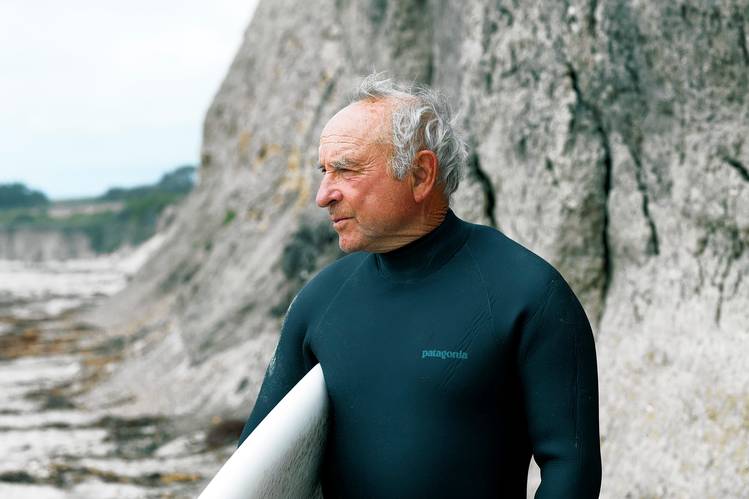
Very much on the flip side of epic, and in many ways even more of a Nothing Burger than usual, we saw another COP conference come and go. The COP27 conference in Egypt actually ended 40 hours later than planned as attendees tried desperately to come away with something positive to talk about from the event, in the form of the Loss & Damage Response Fund. Fundamentally, rich, developed nations will pay reparations to the nations affected the worst through climate change.
Contentiously, it also brings in emerging economies such as China, Russia, Saudi Arabia and other OPEC members that are now among the biggest historic and ongoing contributors to the problem. None of them think they should have to pay, and the final wording of the agreement leaves that point open to interpretation – for now. Interestingly, Australia’s global presence at the table has been recognized again thanks to the Federal Election, and it seems we might be seeing COP 31 down under in 2026.
Another big moment that I have slightly more hope for, In March this year the United Nations Environment Assembly passed a resolution to help end plastic pollution – an agreement described by delegates as the most significant green accord since the 2015 Paris Climate conference. The treaty should be complete some time in 2024, but the landmark agreement this year paves the way for the first global agreement on plastics production.
Sustainability Wins in Politics
Politically, there were a number of big wins for the environment around the world in 2022.
The Federal election in Australia being the first. There is no doubt that the swing to labour but perhaps more notably the remarkable success of so many Independent candidates was built off the back of environmental policies, and Australia has spoken.
But we also need to look over in the States where Biden’s contentious Inflation Reduction Act was signed in August. Among other things it authorised $369 billion dollars of public spending into climate and clean energy projects, and a further $135 billion in tax credits for renewable energy adoption to stimulate the EV market.
And we mustn’t forget Brazil’s significant power shift election from a President seemingly bent on slashing every investment in environmental legislation to one who promises to achieve zero deforestation by 2030.
RedCycle Collapses
Another Big Moment here in Australia albeit on a smaller scale, November saw the collapse of the Redcycle recycling program.
Redcycle is an independent business that works in partnership with over 2000 supermarkets across the country to provide public soft plastics drop-off points.
But when a fire at seemingly the only recycling major centre in Australia set up to handle soft plastics shut down processing of the collected material, it just started piling up, ultimately leading the program to be suspended.
Like many, I have a huge amount of sympathy for Liz Kasell and the RedCycle team. They’ve led a growing movement and awareness around recycling and implemented a very effective collections programme on a national scale.
But it has forced us to ask serious questions around the viability of recycling and our infrastructure here in Australia, including the demand for recycled plastic.
So it was good to see more action taken by the new government to explore circular, with the formation of the first Ministerial Advisory Group on the Circular Economy at the end of November. On announcement of the group, Environment Minister Tanya Plibersek said “better waste management and more effective recycling” are insufficient in reducing waste, meaning the country must “design-out waste in the first place, and make better use of recovered resources”. Hear hear!
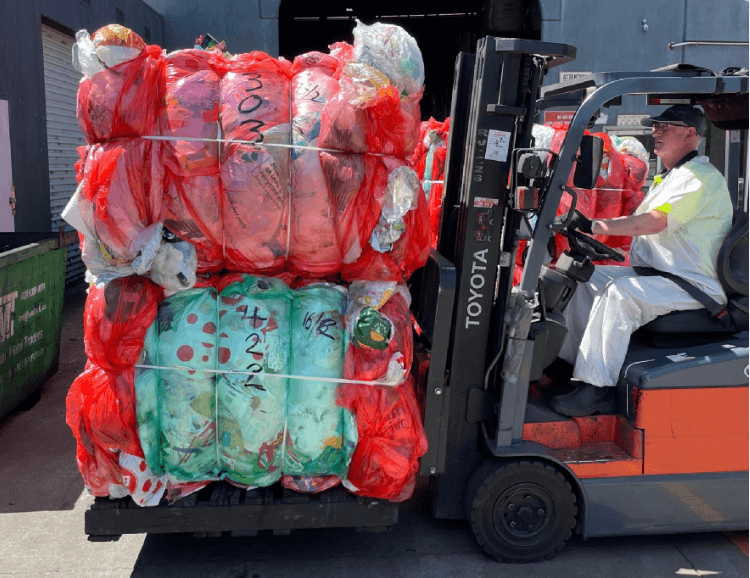
Continued Progress Of Single Use Plastic Bans
In any case, there’s been a great deal of forward momentum with regards single use plastics this year both here in Australia and around the world. In January, WA led the way with bans on banning a variety of single use things other than plastic bags, including straws, cutlery and various polystyrene food containers.
Other states have been following suit, with a phased rollout of single use plastic containers, straws, cotton buds as well as other things like micro-beads used in soaps and other detergents. Typically the bans are neither aligned in timing or scope so while you can’t find a plastic straw in Sydney, you could still be served them in Melbourne until 2023. Still progress is great to see and a huge step forward.
And it’s great to see other countries doing this too. India got in on the act in July by banning single use cups & straws, and as I was preparing this podcast, the UK government announced it too was getting ready to extend its single use bans to include cutlery & plates. By the end of this year Canada will actually have made it illegal to import plastic bags or any plastic food service items at all.
There’s also been a fair bit of PR about progress made with confectionary wrappers, which until recently are largely plastic and non-recyclable.
In June Nestle announced that their Kitkat wrappers sold in Australia were going to be made of 30% recycled plastic, and they further picked up a number of awards in July for their emerging recyclable packaging on smarties containers.
In September Amcor the makers of Cadbury wrappers said they were following suit with 30% recycled material.

Now, if you think the messaging around these brands going ‘green’ just because they’ve popped in 30% recycled plastic into their wrappers is more than a little greenwashy, you won’t be alone. I’m not a materials scientist, but I can’t understand why with the resources these giant brands have they can’t come up with something better than a token effort of using a bit of recycled plastic.
So on a more constructive note, last month Mars Wrigley announced that all of their chocolate bar wrappers will be either recyclable, reusable or compostable by 2024. I knew there was a reason Mars bars were my favourite!
More Quick-Fire Good News Stories
Now there were so many more good news stories from this year, and I can’t possibly cover them all, but here’s a very quick summary of some of the stories I thought were interesting. I’ll put links to them all in the show notes if you want to explore them further.
In good news for replanting efforts, an Australian start up called AirSeed is building an army of drones than can help speed up tree planting by firing up to 40,000 seed pods per day, potentially making reforestation projects 25 times faster and 80% cheaper.
For the first time in a long time, the Great Barrier Reef has seen an increase in hard coral growth and less bleaching in 2022, in fact its shown the best signs of recovery than at any time in the last 35 years. It got an extra 500M in funding from the Federal Government to protect it.
Global Growth in wind and solar seem like they might finally be on track to meet the 1.5C warming target, the Netherlands, Australia and Vietnam having the fastest pace of growth.
For the first time ever renewables produced more energy than coal In the US in 2022, and in October renewables were announced as powered 100% of Greece’s power needs for a most of a day, 46% overall.
France has banned short-haul domestic flights where a 2.5 H rail journey can replace them, and made a new rule that all public car parks must have solar panel roofing.
Scientists have discovered a type of wax worm that can actually eat plastic, which could be another string in the bow of the plastic pollution problem.
And more boffins from the US have discovered a 50% drop in harmful chemicals in the Ozone layer, which means the nefarious hole letting in harmful UV rays could heal itself withing the next 50 years.
Reflecting On Your Own Brand Progress
Now, lets turn our minds away from reflecting on what’s happening outside, and reflect on and celebrate the things you’ve accomplished in your own sustainable brand this year. It’s time to feed your soul with the awesome things you’ve done, both large and small, as well as fill it with gratitude for the people, places and things around you that have made it all possible.
So take a few moments now to reflect on your 2022. As Entrepreneurs we run hard all the time, and I know it can be so hard to remember all the things you’ve done in your business through the year. So here are some questions you might like to ask yourself to jog your memory. Don’t worry no-one has answers to all these questions, but even if you can answer a few of them should give you a nice little glow heading in to your rest period.
- What impact did you brand have this year?
- What economic targets did you achieve?
- What projects did you deliver that move your brand forward?
- What new products did you bring out that make your customers live easier and help them live more sustainably?
- How many more customers did you influence this year to buy better?
- What difference have you made in your team member’s lives? How has your brand’s growth helped other people in your supply chain?
- What advances did you make in materials used?
- What changes did you make that reduce your carbon footprint?
- What suppliers did you influence to cut down on plastic packaging or improve the way they do things?
- What recognition did you get outside your organisation? That could be in the form of awards, nominations, an industry shout out or just some great customer feedback. Go back and have a look at your best reviews from raving fans.
When you’ve worked through your list of accomplishments both big and small, turn your mind to gratitude.
- What things enabled you to do what you did this year?
- What devices and software tools made you more efficient, allowed you or your team to work remotely, or to connect with new people?
- What platforms gave you access to new customers or suppliers?
- And above all, who are you grateful for and why?
- Who are the people who’s tireless and mostly thankless work lets you do what you do?
- Who looks after your customers and takes the lead on looking after the heroes in your mission? Who connected you to new people this year that you might not have met otherwise?
- Who is in your life now that enriches you as a human, whether that be love, friendship, intellectual challenge or has helped you grow in your skills in work and play.
Take the time to appreciate them internally, then make the time to thank them personally for everything they’ve done for you this year.
And on that note I want to say thanks to you guys for listening.
There are so many amazing shows out there and I sincerely appreciate you all for listening in through 2022.
We’re already planning out Season 3, and I am actively seeking feedback for the show. I’d love you to tell me how we can shape it to help you even more? What guests would you like to have on the show? What topics should we cover in more detail?
I have an active post on linked In where I’m calling for your feedback, and I’ll put a link in the show notes in this episode as well as on the podcast page, but it’s also pinned to the top of my LI profile if you would like to have your say.
We’ll be back on air in the 3rd week of January at a new time of 3:30 pm on Mondays instead of Fridays, so until then have a wonderful Christmas break and a Happy New Year, and in January, get right back to the important, meaningful and necessary work of building your brand for a healthier planet.





